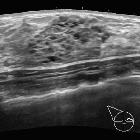Recurrent respiratory papillomatosis







Recurrent respiratory papillomatosis, also known as squamous cell papillomatosis, refers to the occurrence of multiple squamous cell papillomas involving respiratory epithelium, most commonly in the larynx (laryngeal papillomatosis) and less commonly the trachea and bronchial tree (tracheobronchial papillomatosis).
Epidemiology
Squamous cell papillomas are the most common benign tumor of the larynx, especially in children.
There is a characteristic bimodal age distribution.
Juvenile form
- develops prior to 20 years of age, and tends to be more aggressive/recurrent
- HPV infection occurs via vertical transmission, either through the placenta (prior to birth) or by direct inoculation through the birth canal (during birth)
- presence of maternal anogenital condyloma during childbirth is associated with higher chances of RRP, although the vast majority of exposed children are unaffected
Adult form
- develops after 20 years of age, more likely to affect males, and more likely to present with solitary papilloma
- it is presumed that HPV infection occurs via intimate contact in these cases
Pathology
The lesions consist of squamous cell papillomata (abnormal proliferation of squamous epithelium), which are linked to mucosal HPV infection. Because HPV infection is common, while RRP is a rare disease, other (unrecognized) variables must contribute to the disease . Of the numerous HPV genotypes, certain genotypes are recognized in association with RRP:
- HPV-6 and 11 are most commonly implicated (90% total cases), although HPV-16, 18, 31, and 33 also implicated
- HPV-11 is associated with more aggressive papillomatosis
- HPV-16 and 18 are more associated with malignant transformation, although "low risk" sub-types (e.g. 6, 11) have also resulted in malignant degeneration
The papilloma may be sessile, papillary, lobulated, or polypoid.
The distribution of the lesions is most commonly limited to the larynx, including the vocal cords, subglottis, and inferior aspect of epiglottis. Tracheobronchial involvement is less common and occurs in 1-5% of those with laryngeal papilloma. Lung parenchymal involvement is even rarer (~1%). Isolated tracheobronchial involvement without a laryngeal lesion is extremely uncommon and may occur more frequently in the adult form.
The factors resulting in the involvement of the distal airway are not known, although recognized risk factors include HPV-11 infection, less than 3 years of age, tracheostomy, and prior invasive procedures.
Radiographic features
Plain radiograph
Chest radiographs are often normal, especially if lesions are limited to the larynx. If more extensive, small lesions can be appreciated which may appear solid or cavitatory .
When papillomas result in airway obstruction then atelectasis, bronchiectasis and mucus plugging (finger in glove appearance) may be seen.
CT
Typically CT demonstrates thin-walled cysts with adjacent nodules. These are 2-3 mm in size .
With more widespread disease there may be a dorsal (posterior) predilection due to gravity.
CT is also able to demonstrate distal atelectasis, bronchiectasis and mucus plugging.
Treatment and prognosis
Although respiratory papillomas tend to be slow-growing, treatment is usually ineffective with high recurrence rate (~ 90%). With disease progression and dissemination comes gradual respiratory failure and overall poor prognosis.
Surgical excision may be performed as a palliative measure to address obstructive papilloma. Bronchoscopic laser ablative procedures have largely been replaced by microdebrider blade techniques. Notably, disease-free surgical margins are not pursued because of the difficulty in distinguishing unaffected epithelium. Also, tracheostomy is avoided due to a known associated with distal tracheal spread.
There is a small risk of malignant degeneration into squamous cell carcinoma. This is more common in adults (3-7%) than children (<1%) . Risk factors include high-risk HPV genotype, smoking, and prior radiation therapy among others.
Differential diagnosis
General imaging differential considerations include:
- tracheal masses: for tracheal lesions
- granulomatosis with polyangitiis: for lung lesions
Siehe auch:
- Bronchiektasen
- Atelektase
- Granulomatose mit Polyangiitis
- Raumforderungen der Trachea
- Tracheobronchopathica osteochondroplastica (TBO)
- Heiserkeit
- biliäre Papillomatose
- Papillomatose
- laryngealer Polyp
- Finger in Handschuh Bild
- Juvenile Papillomatose der Mamma
und weiter:

 Assoziationen und Differentialdiagnosen zu tracheobronchiale Papillomatose:
Assoziationen und Differentialdiagnosen zu tracheobronchiale Papillomatose:









